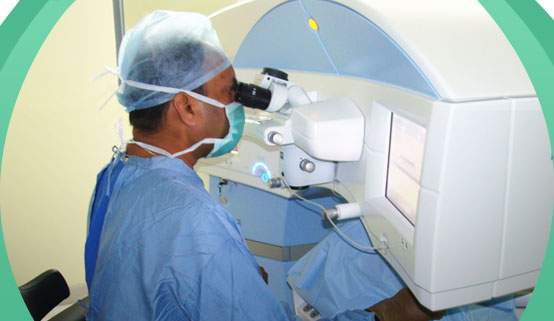|
|
 |
|
|
|
|
What is a Retinal Detachment?
Retinal detachment, as the name
suggests, is the detachment of retina
from underlying structures of eye.
Symptoms of retinal detachment
Symptoms of retinal detachment include:
- Flashes of light
- Floaters (cobwebs)
- Loss of field of vision
(blind spot or shadow)
Flashes and floaters occur when
the vitreous gel that fills up 80
percent of the volume of the eye
begins to liquefy and pulls away
from the back of the eye. Floaters
are protein aggregates that are
more pronounced when they first
occur and are typically seen most
easily against a bright background.
Bleeding inside of the eye can also
cause a sense of looking through
floaters.
If the inner lining of the eye,
the retina, is thin, the vitreous
can pull on this area to produce
a tear. Persistent pull on the tear
can lead to a retinal detachment,
a condition in which fluid gets
under the retina and lifts part
or all of the retina away from the
back of the eye.
What are the Risk Factors for RD?
Risk factors for retinal detachment
include:
- Nearsightedness
- Family History
- Trauma (e.g. blunt injury
in the past)
How does the doctor know whether an infant has retinopathy of prematurity?
Treatment
Fresh retinal tears and detachments
should be treated urgently since
rapid loss of vision can occur.
The success rate for repair of a
recent uncomplicated retinal detachment
approaches 90 percent. Laser
treatment can often be conducted
in the office to seal a retinal
tear if there is no detachment.
However, close follow-up is necessary
to make certain that the retina
does not detach despite laser treatment.
Pneumatic retinopexy is also
an office-based procedure using
laser or freezing therapy to seal
off a tear, followed by injecting
a small gas bubble into the eye
to reattach the retina from inside
the eye.
Scleral buckle surgery is
conducted in the operating room.
A permanent, external support to
the peripheral retina is supplied
by placing a silicone band around
the outside of the eye. Such a buckle
is generally not visible after the
eye has healed.
Vitrectomy surgery is also
an operating room procedure that
is used by itself or can be combined
with a scleral buckle. A small cutting
instrument is used to enter the
eye through a 1 mm incision, and
the vitreous gel is removed and
replaced with a gas bubble. The
advantage of this method is that
all the debris, scar tissue and
membranes on the retina can be removed,
and the retina flattened at the
time of surgery. A laser is used
to seal off the tears.
Gas and silicone oil are
support agents used inside the eye
to keep the retina attached while
permanent bonding occurs. A gas
bubble is gradually absorbed over
a period of several days to several
weeks, depending on the specific
gas used. A patient cannot travel
by air with a gas bubble inside
the eye. Silicone oil may be necessary
if longer support is required. This
allows the eye more time to heal.
However, silicone oil is often removed
from the eye by a later surgical
procedure once the retina is stable.
Patients with silicone oil inside
their eyes can fly safely.
Vitrectomy, scleral buckle and
gas are sometimes used in combination.
Anatomical success rate can be as
high as 80 – 90 percent. However,
some eyes will develop a recurrent
retinal detachment and may need
additional surgery.
Surgery is generally performed
as an outpatient procedure,
and patients may go home the same
day.
|
|
|
|
|
|
